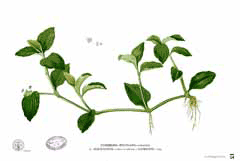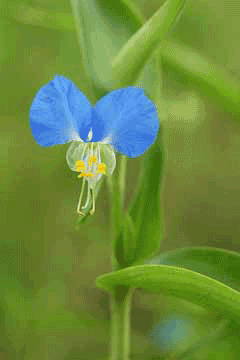 |
|
http://commons.wikimedia.org/wiki/File:Commelina_communis_Blanco1.13.jpg |
 |
| http://commons.wikimedia.org/wiki/User:NotAnonymous |
Translate this page:
Summary
Physical Characteristics

 Commelina communis is a PERENNIAL growing to 0.8 m (2ft 7in).
Commelina communis is a PERENNIAL growing to 0.8 m (2ft 7in).
See above for USDA hardiness. It is hardy to UK zone 7. It is in flower from July to September, and the seeds ripen from August to October. The species is hermaphrodite (has both male and female organs).
Suitable for: light (sandy) and medium (loamy) soils and prefers well-drained soil. Suitable pH: mildly acid, neutral and basic (mildly alkaline) soils. It can grow in semi-shade (light woodland) or no shade. It prefers dry or moist soil.
UK Hardiness Map
US Hardiness Map
Synonyms
Plant Habitats
Cultivated Beds;
Edible Uses
Edible Parts: Flowers Leaves Shoots
Edible Uses:
Leaves, flowers and young shoots - raw or cooked[2, 105, 177]. Chopped finely and added to salads or cooked as a potherb[183]. A sweet taste with a mucilaginous texture[179].
References More on Edible Uses
Medicinal Uses
Plants For A Future can not take any responsibility for any adverse effects from the use of plants. Always seek advice from a professional before using a plant medicinally.
Antibacterial Astringent Depurative Diuretic Febrifuge
The leaves are depurative, diuretic and febrifuge[116, 147]. Used as a throat gargle to relieve sore throats and tonsilitis[116, 266]. A decoction of the dried plant is used to treat bleeding, diarrhoea, fever etc[218]. Extracts of the plant show antibacterial activity[218].
References More on Medicinal Uses
The Bookshop: Edible Plant Books
Our Latest books on Perennial Plants For Food Forests and Permaculture Gardens in paperback or digital formats.

Edible Tropical Plants
Food Forest Plants for Hotter Conditions: 250+ Plants For Tropical Food Forests & Permaculture Gardens.
More

Edible Temperate Plants
Plants for Your Food Forest: 500 Plants for Temperate Food Forests & Permaculture Gardens.
More

More Books
PFAF have eight books available in paperback and digital formats. Browse the shop for more information.
Shop Now
Other Uses
Dye
A bright blue dye is obtained from the petals[74].
Special Uses
References More on Other Uses
Cultivation details
Prefers a light well-drained loam with added leafmold[1, 42]. Requires a sheltered position[42]. This species is commonly cultivated as a vegetable in China[2]. The plant can be invasive[42], the stems sprawling along the ground and rooting as they go[K].
References Carbon Farming Information and Carbon Sequestration Information
Temperature Converter
Type a value in the Celsius field to convert the value to Fahrenheit:
Fahrenheit:
The PFAF Bookshop
Plants For A Future have a number of books available in paperback and digital form. Book titles include Edible Plants, Edible Perennials, Edible Trees,Edible Shrubs, Woodland Gardening, and Temperate Food Forest Plants. Our new book is Food Forest Plants For Hotter Conditions (Tropical and Sub-Tropical).
Shop Now
Plant Propagation
Seed - sow March in a greenhouse. The seed usually germinates in 4 - 5 weeks at 20°c[164]. When they are large enough to handle, prick the seedlings out into individual pots plant them out in late spring or early summer, after the last expected frosts. Division in early spring. Make sure that each portion has at least one growing bud[111, K]. Cuttings during the growing season. Very easy[200].
Other Names
If available other names are mentioned here
Asiatic Dayflower, Day Flower, A tor, Danzhuye, Duck's tongue plant, Gangi gadda, Kannang keeray, Miandazi, Rau trai, Spider wort, Thai lai trang, Yashecao, Zhuyecao,
Native Range
TEMPERATE ASIA: Georgia, Russian Federation (Habarovskij kraj, Primorye, Amur, Sakhalin), China, Korea, Japan (Hokkaidô, Honshu, Kyushu, Shikoku), Taiwan EUROPE: Russian Federation (Astrakhan, Volgogradskaja oblast)
Weed Potential
Right plant wrong place. We are currently updating this section.
Please note that a plant may be invasive in one area but may not in your area so it's worth checking.
This plant can be weedy or invasive. Introduced to central and southeastern Europe and eastern North America where it has spread to become a noxious weed.
Conservation Status
IUCN Red List of Threatened Plants Status : This taxon has not yet been assessed.

Growth: S = slow M = medium F = fast. Soil: L = light (sandy) M = medium H = heavy (clay). pH: A = acid N = neutral B = basic (alkaline). Shade: F = full shade S = semi-shade N = no shade. Moisture: D = dry M = Moist We = wet Wa = water.
Now available:
Food Forest Plants for Mediterranean Conditions
350+ Perennial Plants For Mediterranean and Drier Food Forests and Permaculture Gardens.
[Paperback and eBook]
This is the third in Plants For A Future's series of plant guides for food forests tailored to
specific climate zones. Following volumes on temperate and tropical ecosystems, this book focuses
on species suited to Mediterranean conditions—regions with hot, dry summers and cool, wet winters,
often facing the added challenge of climate change.
Read More
Expert comment
Author
L.
Botanical References
58200266
Links / References
For a list of references used on this page please go here
Readers comment
| Add a comment |
|
If you have important information about this plant that may help other users please add a comment or link below. Only comments or links that are felt to be directly relevant to a plant will be included. If you think a comment/link or information contained on this page is inaccurate or misleading we would welcome your feedback at [email protected]. If you have questions about a plant please use the Forum on this website as we do not have the resources to answer questions ourselves.
* Please note: the comments by website users are not necessarily those held by PFAF and may give misleading or inaccurate information.
To leave a comment please Register or login here All comments need to be approved so will not appear immediately.
|
Subject : Commelina communis
|
|
|
|